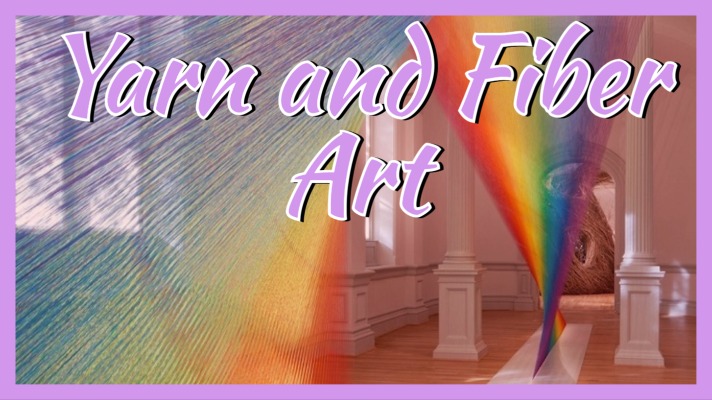For most of us, yarn and fiber are things we use in our crochet or knitting. Some of us might use fiber for spinning, or dye it with different colors. We might even do some weaving or embroidery, but there are some people out there, who have taken these somewhat basic materials and brought it to the next level - Fiber artists in the full sense of the word.
They take fiber, thread and yarn and create the most astonishing installations with them. Things most of us can't event imagine possible. They exhibit at museums, art shows and galleries around the world and give the term "fiber arts" a whole new meaning. Let's take a closer look at some of their work.
Vanessa Barragão
Portuguese fiber artist Vanessa Barragão was born in the seaside, in a place called Albufeira. Growing up near the ocean, her vision and passions were heavily inspired by it. She studied fashion design for 6 years, a period she describes as a very important stage in her artistic development. She became more conscious about consumption, sustainability and being more eco-friendly in her daily routine as well as her art projects.
Her textile art studio is focused on handmade and ancestral techniques, using wastes to create artwork, showing the importance of preserving handmade processes as well as upcycling and recycling to fight against the destruction and pollution of our planet.
All the materials she uses come from wastes, leftovers and dead-stocks of the Portuguese textile industry, and all the yarns are submitted to a cleaning and selection process before being used.
Her creations and installations range anywhere for small wall decorations for your home (which can be purchased on her shop) and up to ones the size of a house wall! Some can be viewed in different galleries, and some can be found in homes of simple people like you and me. Isn't that fun?

A unique Botanical Tapestry designed and constructed by textile artist Vanessa Barragão
Agnes Hansella
Agnes Hansella is an Indonesian fiber artist working in Jakarta and Bali. She is a self-taught macrame artist, but she wasn't always into fiber-arts. In fact, she studied audio engineering in Vancouver, Canada, and got a bachelor's degree in Jakarta Institute of Arts majoring in sound for film. It was only after that she started to show interest in the world of fiber arts and completely shifted her focus.
Considering the fact that she only started doing macrame in 2017, her raise to fame was quite quick. The pieces that have garnered her the world's attention on social media are large macrame installations at Loca Beach House, an open-air structure in Bali.
Currently, Hansella is focusing on her career as an artist. She says she would like to see how far she can go and what she can make with her hands.

The macrame creation which made her famous - Agnes Hansella's Loca Beach House Installation
Bisa Butler
Bisa Butler is an American fiber artist known for her vibrant, quilted portraits celebrating Black life - from everyday people to notable historical figures. While completing her master's degree in art education from Montclair State University, she took a Fiber Art class that inspired her choice of quilting as an artistic medium.
Butler's quilts both heavily incorporate African textiles as well as expand on a rich African American quilting tradition. "In my work I am telling the story— The African American side— of this American life" she says. Her goal is, that the people who view her work feel the value and equality of all people. She does so by presenting all of her figures with the richness and dignity they deserve whether they are from a humble background or the upper classes.
Butler's quilted portraits use vibrant, intense layers of colors to engage viewers with topics such as family, community, and migration. She started by depicting her family and then expanded to her larger community.
Her works are included in art collections at numerous museums and galleries such as the Art Institute of Chicago, Orlando Museum of Art, the Museum of Fine Arts in Boston and many more.
In 2019 Butler was a finalist for the Museum of Arts and Design Burke Prize, and in 2020 a portrait she made was featured as a cover for Time Magazine’s special issue honoring the 100 Women of the Year.

Quilted portrait by Bisa butler
Carol Milne
Carol Milne is sort of an odd-ball in this list. She isn't exactly a fiber-artist, but rather an artist who's work connects to the world of fiber arts. She is a sculptor working primarily with glass. And here is where it gets interesting - Carol is the lone pioneer in the field of knitted glass. Pushing the limits of her material through persistent and relentless experimentation, determined to combine her passion for knitting with her love for cast glass sculpture, she developed a variation of the lost wax casting process to cast knitted work in glass.
Knitted glass! That sounds like something out of a fairytale. Who would have even thought it to be possible? Well, Milne proves that it is possible. And boy, it is amazingly beautiful!
Some of her work actually depicts the act of knitting. A salute to work in progress. These cast glass sculptures of knitted artwork with knitting needles in place celebrate the act of creation as if it were a finished piece. Other sculptures are simply works of arts which were knitted with glass. Yes, finished items knitted out of glass instead of yarn. Unbelievable! She actually has socks, bowls and baskets and even some figures - all knitted out of glass.

A salute to work in progress - Carol Milne
Chiharu Shiota
Shiota was born in Osaka, Japan and wanted to be an artist since she was twelve. She studied in several art-institutions and moved quite a lot, before finally settling down in Berlin, Germany, where she currently lives and creates.
Using woven yarn, the artist combines performance, body art and installations in a process that places at its center the body. Her flexible artistic approach plays with the notions of temporality, movement and dreams, and demands a dual engagement from the viewer, both physical and emotional. Confronting fundamental human concerns such as life, death and relationships, Shiota explores human existence throughout various dimensions.
Her work has been exhibited all around the world, and she has won numerous prizes for it.

Demands both both physical and emotional engagement - Chiharu Shiota
Ksenia Zimenko
Russian embroidery artist Ksenia Zimenko draws her inspiration from nature. She captures the beauty of mountains, waterfalls, trees, and sunsets with bead embroidery designs that shimmer when the light hits them.
The talented textile artist puts a lot of detail in her work and can sometimes spend several weeks working on one specific piece. That might not sound like a lot of time for a work of art, but considering that her creations are usually no bigger than the palm of her hand, that is indeed quite a long while.
Her art plays with texture and volumetric structure in a way not often seen or expected when one thinks of embroidery. Zimenko also chooses to add her iridescent, 3D embellishments where they will make the most impact, making her landscape shine or reflect in the exact same way it would in nature, and, in a sense, bring certain elements in the design to life.
Zimenko’s beautiful beaded embroidery is not currently exhibited anywhere, but she does sell it, mainly on her Etsy shop.

Using iridescent 3D embellishments to bring nature to life - Ksenia Zimenko
Sui Park
Sui Park is a New York based artist born in Seoul, Korea. She studied Interior Architecture and Environmental Design and also has several degrees in fiber arts.
Although she uses different techniques of weaving in her art, the materials themselves are not really the kind we are used to in the fiber arts world. Her organic sculptures, inspired directly from nature, are made from weaving Monofilament and Cable Ties together. The use of inexpensive, manufactured materials plays on the idea that while humans are capable of creating objects that mimic nature, unlike organisms, those physical entities remain static, and frozen in their potential evolution. She describes her work as "3-dimensional organic forms and biomorphic shapes".
Her creations are often a collection and repetition of objects, placed in clusters on gallery floors and walls, in nature among plants, or traveling through space - hanging in the air. They are made to mimic certain elements we all know and recognize - nighttime seas, prickly moss, and vibrant amorphous creatures, but there is a mesmerizing dissonance between what they resemble and the materials they are made of.

Dissonance between the subjects and the materials they are made of - Sui Park
Eric Rieger
Eric Rieger, also known as HOTTEA is a street artist in Minnesota. After going to jail for his graffiti art, he went to school to become a graphic designer. Now, in attempt to still create street art, but the kind which can be easily removed, he uses brightly colored yarn to design words and images on fences, walls and poles around his city.
The latest development in his style happened when he started to focus on hanging yarn from canopies over walkways on freeways. His work started to be discussed online and gained him interest from around the world. He continued installing pieces throughout the Twin Cities and eventually started to install pieces of his work in local businesses, which later on led to him being commissioned to create installations for art institutes, galleries and museums.
Even though HOTTEA is now exhibiting his work indoors, he is still creating public art out on the streets, and in 2013 was named Best Street Artist in Minneapolis.

Hanging yarn from canopies over walkways on freeways - HOTTEA

